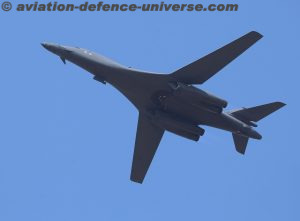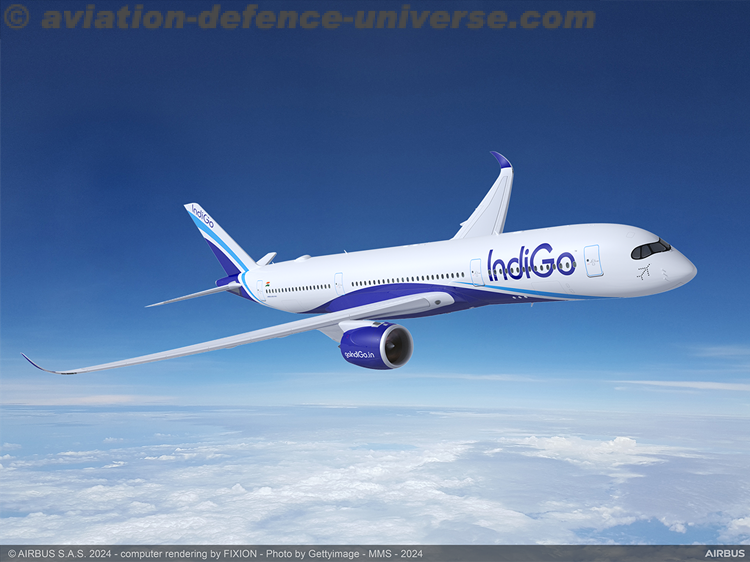 Dear Friends,
Dear Friends,
This is Sangeeta Saxena, Editor Aviation & Defence Universe getting you live from Aero India 2023. Today is Tuesday, February 14 and the United States Air Force (USAF) has expanded its lineup for Aero India 2023 with the arrival of two B-1B Lancers after a journey to India from their temporary duty location at Andersen Air Force Base, Guam.
The B-1B Lancer, a supersonic heavy bomber, is a truly remarkable aircraft, capable of carrying out missions worldwide from its bases in the United States, as well as from forward deployed locations. It carries the largest conventional payload of both guided and unguided weapons in the U.S. Air Force and is considered the backbone of America’s long-range bomber force.
You make recall February 3, 2021, when the B-1B landed in India for the first time and conducted a fly-by on the inaugural day of Aero India 2021, escorted by an Indian Tejas fighter. Commonly called the “Bone” (for “B-one”), the return of the long-range, supersonic, heavy bomber to India to participate in Aero India 2023 underscores the importance the United States places on the growing strategic partnership with India.
Major General Julian C. Cheater, Assistant Deputy Under Secretary of the Air Force, International Affairs, said, “The B-1 offers flexible options to senior leaders and combatant commanders. Greater integration with our Allies and partners throughout the region is a positive step towards greater interoperability.”
Rear Admiral Michael Baker, Senior Defense Official and Defense Attaché at the U.S. Embassy in New Delhi, said, “We are happy to have the B1 in India for the second time. These bombers made the journey from South Dakota to Guam and then to India just to add another exciting dimension to Aero India ‘23. It’s a long mission to travel from the continental U.S. to the Indian Ocean; but it was worth it to be part of the biggest air show in the region hosted by our Major Defense Partner, India. The U.S. and India continue to deepen Defense cooperation. We have two great militaries that are even better when we work together.”
The array of U.S. aircraft already participating in Aero India 2023 shows U.S. support for Aero India 2023 and the strength of the U.S.-India partnership.
In addition to the B-1s, the U.S. lineup includes the U.S. Air Force’s newest fifth-generation fighters – the stealthy, supersonic, multirole F-35A Lightning II and F-35A Joint Strike Fighter. Throughout the week, an F-16 Fighting Falcon duo is conducting daily aerial demonstrations, showcasing the capability of one of the USAF’s leading fighter jets. The U.S. Navy F/A-18E and F/A-18F Super Hornet multirole fighters are on static display at Yelahanka Air Force Base in Bengaluru.
B-1B Lancer, long-range, multi-role, heavy bomber from the Ellsworth Air Force Base, South Dakota base (demo). Now let us get to know this flying enigma a little more. The B-1A was initially developed in the 1970s as a replacement for the B-52. Four prototypes of this long-range, high speed (Mach 2.2) strategic bomber were developed and tested in the mid-1970s, but the program was canceled in 1977 before going into production. Flight testing continued through 1981.
The B-1B is an improved variant initiated by the Reagan administration in 1981. Major changes included and additional structure to increase payload by 74,000 pounds, an improved radar and reduction of the radar cross section by an order of magnitude. The inlet was extensively modified as part of this RCS reduction, necessitating a reduction in maximum speed to Mach 1.2.
The first production B-1 flew in October 1984, and the first B-1B was delivered to Dyess Air Force Base, Texas, in June 1985. Initial operational capability was achieved on Oct. 1, 1986. The final B-1B was delivered May 2, 1988.
The United States eliminated the nuclear mission for the B-1 in 1994. Even though the Air Force expended no further funding to maintain nuclear capabilities, the B-1 was still considered a heavy bomber equipped for nuclear armament until 2007. The conversion to conventional only began in November 2007 under the original START treaty and was completed in March 2011 under the New START treaty. To make that conversion possible, two steps were taken:
During the first step a metal cylindrical sleeve was welded into the aft attachment point of each set of B-1 pylon attachments. This prevented installing B-1 Air Launched Cruise Missile pylons.
During the second step two nuclear armament-unique cable connectors in each of the B-1 weapons bays were removed. This prevented the pre-arm signal from reaching the weapons.
The B-1B holds almost 50 world records for speed, payload, range, and time of climb in its class. The National Aeronautic Association recognized the B-1B for completing one of the 10 most memorable record flights for 1994. The most recent records were made official in 2004.
The B-1B was first used in combat in support of operations against Iraq during Operation Desert Fox in December 1998. In 1999, six B-1s were used in Operation Allied Force, delivering more than 20 percent of the total ordnance while flying less than 2 percent of the combat sorties.
During the first six months of Operation Enduring Freedom, eight B-1s dropped nearly 40 percent of the total tonnage delivered by coalition air forces. This included nearly 3,900 JDAMs, or 67 percent of the total. In Operation Iraqi Freedom, the aircraft flew less than 1 percent of the combat missions while delivering 43 percent of the JDAMs used. The B-1 continues to be deployed today, flying missions daily in support of continuing operations.
So friends ADU was privileged to see this enigma flying over Yelahanka skies. The most awe inspiring metallic bird ever. We will keep getting you live moments from the tarmac. So bye till we meet again.


























































































































